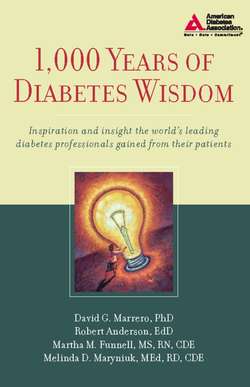Читать книгу 1,000 Years of Diabetes Wisdom - David G. Marrero - Страница 8
Determination Is the Key
Оглавлениеby Joyce Green Pastors, dietitian,
and Terry Saunders, psychologist, Charlottsville, VA
Over the past few years, we have been providing lifestyle change counseling to selective patients with diabetes. These patients have agreed to be videotaped with the purpose of using segments of the videos for a professional education workshop.
Our first videotaped patient was a complex case—a 48-year-old female, severely obese, with a history of yo-yo dieting, an eight-year history of type 2 diabetes, and very insulin resistant. The patient had a history of hypertension, heart disease, and depression and had been a smoker since age 16. Along with these factors, she had a complicated challenging social and financial situation, with three children ranging in age from 12 to 28, all living in the same home, and a husband who had died of cancer six years previously.
We began our first taping session just before Thanksgiving, which we initially thought was a mistake given the challenge of making lifestyle changes during the holiday season. We completed a lifestyle assessment and set some initial goals regarding awareness—determining a baseline of physical activity and becoming aware of late-night snacking patterns. The patient wanted to focus on just getting through the holiday.
We suggested working together to develop a plan for handling the holidays—something she could commit herself to and feel confident about. Specific aspects she was concerned about were baking, eating pies, and buffet-style eating throughout the day. Based on our philosophy of developing patient-centered goals and beginning with small, realistic, and achievable goals, we identified and agreed on three behavioral goals—eating two pieces of pie during the Christmas week, drinking sips of water while baking, and eating meals sitting down.
Her house was a focal point for visits by family and friends, who always dropped in expecting to find good things to eat. We discussed the possibility of having a family conversation to solicit support and develop some alternatives to the family traditions.
All of this sounded good in theory, but at the end of that session, we both had a sinking feeling that very little would be achieved. So much was stacked against the possibility of success—her history of weight gain during past holiday seasons, her pattern of overindulgence and sedentary living, and the long history of unhealthy family eating traditions. We really wanted her to succeed, but we didn’t have a lot of hope.
The videotape of our next session after the holidays is a classic example of body language speaking louder than words. To our surprise and jubilation, she went on to report that she had lost four pounds and bubbled over with excitement as she told us about her successes and new family traditions. She had talked with her children before Christmas about the behavioral goals we had agreed on, commented on how difficult it would be, and mentioned that it would be nice if they could just forego tradition. They proceeded to make suggestions about how they could add a fruit platter and fresh vegetable tray to the table instead of other high-calorie and high-fat choices.
And here was the holiday gift for us. For years, we had been casting ourselves as firm believers in empowerment and the patient-centered approach to behavior change. But what this showed us was that however much we might have believed intellectually in the approach, we still didn’t fully believe that people can change their habits. This was an especially powerful realization because we would be the first to point out how little confidence others, the prime example being physicians, often show in the possibility of positive behavior change. We were reminded to look inward, re-examine our own beliefs, and recognize our own capacity to stereotype people based on their weight, past history, personal preferences, and family traditions.
